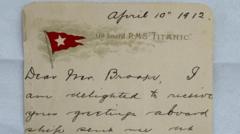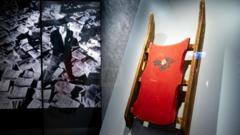The handwritten note, dated 10 April 1912, reflects Colonel Gracie's omens about the "fine ship" and his intent to "await my journey's end" before making assessments. Gracie boarded the Titanic in Southampton, embarking on a voyage towards New York City. Tragically, the ship sank just five days later after striking an iceberg during its journey across the North Atlantic, leading to one of maritime history's deadliest disasters, with over 1,500 lives lost out of approximately 2,200 passengers and crew onboard.
Gracie wrote the letter from his first-class cabin (C51) while the ship stopped in Queenstown, Ireland, before continuing to its ill-fated destination. The auction, facilitated by Henry Aldridge and Son in Wiltshire, showcased the letter as the highest-priced correspondence ever from the Titanic, indicating its significance to collectors and historians alike. Colonel Gracie is known for his harrowing account of survival during the sinking, where he recounted being thrown into the frigid waters yet somehow finding refuge on an overturned lifeboat. Despite his survival, Gracie's health suffered significantly, and he later succumbed to complications from diabetes following an episode of hypothermia and wounds sustained during the tragedy. His firsthand account culminated in the publication of "The Truth About The Titanic," providing essential insights into the ill-fated journey.
Gracie wrote the letter from his first-class cabin (C51) while the ship stopped in Queenstown, Ireland, before continuing to its ill-fated destination. The auction, facilitated by Henry Aldridge and Son in Wiltshire, showcased the letter as the highest-priced correspondence ever from the Titanic, indicating its significance to collectors and historians alike. Colonel Gracie is known for his harrowing account of survival during the sinking, where he recounted being thrown into the frigid waters yet somehow finding refuge on an overturned lifeboat. Despite his survival, Gracie's health suffered significantly, and he later succumbed to complications from diabetes following an episode of hypothermia and wounds sustained during the tragedy. His firsthand account culminated in the publication of "The Truth About The Titanic," providing essential insights into the ill-fated journey.

















